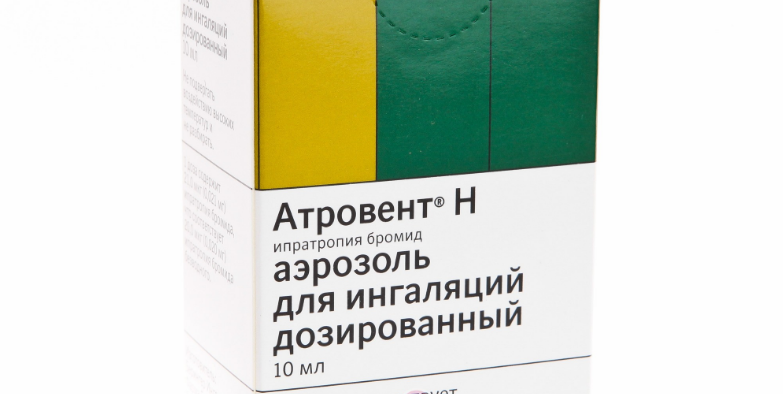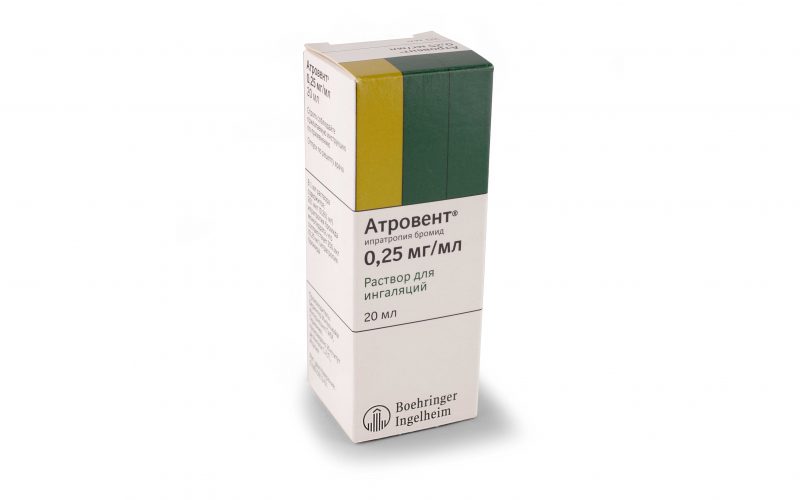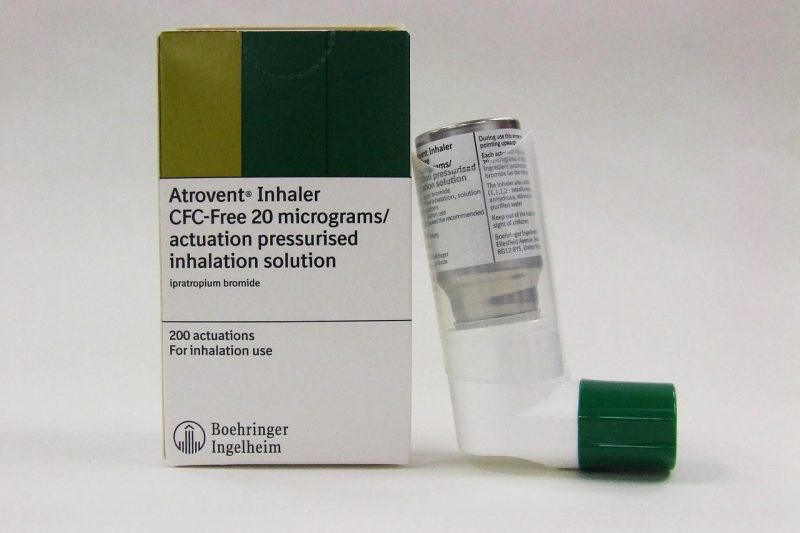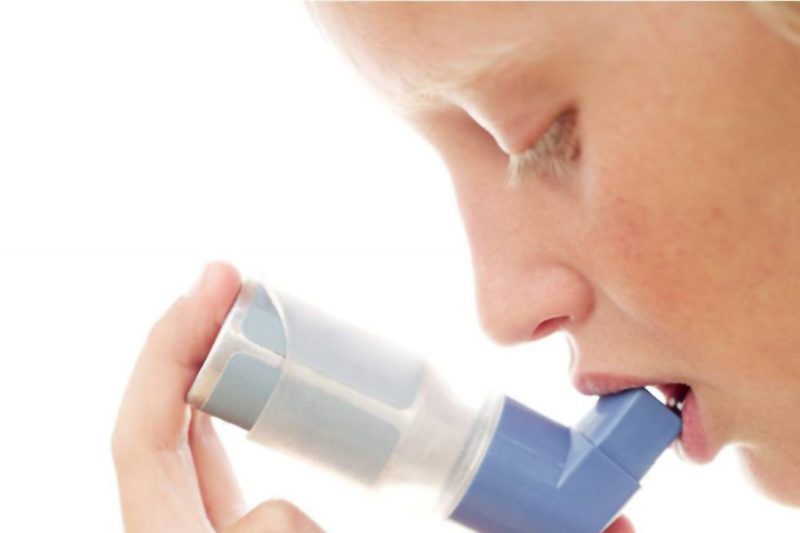Atrovent is a medication through which spasms of the muscles responsible for the work of the respiratory tract are stopped. The m-cholinergic blocker is in the form of an inhalation solution. The drug should be taken in full accordance with the recommendations of the doctor and the manufacturer's instructions.
Material Content:
- 1 The composition of the drug
- 2 Pharmacological properties and pharmacokinetics
- 3 In what cases is Atrovent prescribed
- 4 Instructions for use of the solution for inhalation
- 5 During pregnancy and lactation
- 6 Drug interaction
- 7 Contraindications, side effects and overdose
- 8 Analogues of the drug
- 9 Which is better, Atrovent or Berodual
The composition of the drug
The high efficiency of Atrovent is due to the components that it contains. The active substance of the therapeutic composition is ipratropium bromide monohydrate. Disodium edetate, hydrochloric acid, benzalkonium chloride, sodium chloride and purified water are used as auxiliary ingredients.
The composition of the colorless liquid should not be sediment and foreign particles.
The kit contains a bottle, the volume of which is 20 ml, a plastic dropper, instructions for use. Atrovent is not released in the form of capsules and tablets.
Pharmacological properties and pharmacokinetics
Atrovent for inhalation is a bronchodilator that can suppress bronchoconstriction of a reflex nature.
Among its advantages:
- restoration of indicators of external respiration;
- lack of irritating effect;
- increase in forced air;
- blocking m-cholinergic receptors;
- decrease in intracellular calcium concentration;
- improving the general condition of the patient.
The drug does not penetrate the blood through the gastrointestinal tract. Bioavailability is 2-3%. Atrovent does not accumulate in the functional tissues of the body.The maximum positive effect occurs 1-2 hours after the session.
Atrovent is unable to penetrate the blood-brain barrier. The metabolism of the active ingredient and auxiliary ingredients occurs in the liver. The elimination half-life takes 1.5 hours.
Thanks to the timely use of Atrovent, the regeneration process is accelerated, the likelihood of developing negative consequences is reduced. The beneficial effect lasts for 6 hours. When inhaled, about 30% of the treatment composition gets into the lungs. The binding of proteins to the active substance occurs at a minimum level.
Inhalations are allowed for patients of different age categories. Through Atrovent, the ailment arising from the negative impact of the external environment is removed. Factors that can cause deterioration include cold air, chemicals, and tobacco smoke.
In what cases is Atrovent prescribed
Inhalations with Atrovent are prescribed if the patient has bronchospasms.
Such a symptom is present in the clinical picture of obstructive bronchitis and emphysema.
A significant reason for the appointment of this drug is bronchial asthma. In the latter case, Atrovent is used together with beta-2 agonists.
Read also: bronchial asthma
The medication is not used as a remedy for the relief of acute attacks of the disease. When appointing Atrovent, the pathologies present in the patient's history must be taken into account.
It is strictly forbidden to independently increase the dosage of the drug.
Atrovent is often used in parallel with the following medicines:
- Ambroxol;
- Berotek;
- Bromhexine.
When carrying out inhalations, precautionary measures must be taken. The treatment solution should not get into the eyes. If the patient suffers from angle-closure glaucoma, drops that narrow the pupil are instilled into him before the session. Treatment is prescribed only after consulting an ophthalmologist. For the procedure, you need a nebulizer. The size of the mask depends on the age of the patient.
Instructions for use of the solution for inhalation
Atrovent is a drug of synthetic origin.
It is used, guided by the following algorithm:
- Remove the protective cap from the aerosol.
- They exhale slowly and apply a tip (mask) to the mouth. The bottle with the drug should be inverted.
- During inhalation, they press the valve, releasing a single dose of the drug.
- Hold your breath.
- Take away the tip (mask) and exhale slowly.
After this, it remains only to return the protective cap to its place. The tip is washed after each session. To do this, use a detergent and running water.
If more than three days have passed between the procedures, a single press on the valve is performed before the session. A day you can spend no more than 12 inhalations.
The daily rate of Atrovent is determined individually. In this case, the doctor must take into account the diagnosis, concomitant pathologies (if any), the age and general condition of the patient. The dose is increased only after passing control studies. The decision to change the order of use of the drug is made by the doctor.
Treatment of minor patients and adults suffering from an ailment of moderate and severe severity should be carried out under the supervision of a doctor.
If the patient uses a nebulizer, before the session it is necessary to dilute the medicine with physiological saline. The composition remaining after inhalation cannot be reused.
To determine the volume of the drug mixture remaining in the bottle, the bottle is placed in a container of water. The protective cap is previously removed.
During pregnancy and lactation
Atrovent is not prescribed for pregnant women and nursing mothers. This is due to the fact that there is no reliable information about the consequences of such therapy.Clinical studies have not been conducted, so it is impossible to guarantee that the components of the solution are safe for the unborn child.
Atrovent can not be used in the first three months of pregnancy. It is during this period that organogenesis occurs, vital systems in the fetus are formed.
In the second and third trimesters, the indicated bronchodilator is used if the expected benefit to the mother is higher than the possible consequences for the unborn child.
The same goes for women who are breastfeeding. Due to the lack of necessary data, Atrovent for lactation is prescribed only in case of emergency. Treatment is carried out under the supervision of a physician.
Drug interaction
When drawing up a therapeutic regimen, the effect that occurs when Atrovent is combined with other medicines is necessarily taken into account.
The result may be as follows:
- with xanthine derivatives - increased bronchodilator action;
- with antidepressants, antiparkinsonian drugs - a more powerful anticholinergic effect;
- with medicines that have anticholinergic properties - an additive effect, when the drugs strengthen each other's effects;
- with disodium cromoglycate for inhalation - precipitation (a reaction in which the formation and precipitation of soluble antigens and antibodies occurs).
If the patient to whom Atrovent has been prescribed is still taking any medications, you should definitely tell the doctor about this.
Contraindications, side effects and overdose
Atrovent is not prescribed for hypersensitivity to the components of the composition and atropine. Particular caution should be exercised in the treatment of the elderly and children under the age of 6 years. A good reason for refusing treatment with the drug may be prostatic hyperplasia, angle-closure glaucoma, obstruction of the urinary ducts, cystic fibrosis.
In case of violation of the prescribed treatment regimen, the following side effects occur:
- Strong headache;
- loss of orientation in space;
- violation of the stool;
- urine retention;
- debilitating cough;
- increased heart rate;
- laryngospasm;
- swelling of the mucous membranes;
- dyspepsia;
- allergy;
- rashes on the skin;
- local irritation;
- increased intraocular pressure.
Atrovent affects the ability to concentrate.
Therefore, when undergoing therapy, you should limit the time spent driving and in the workplace. The concentration of attention may be reduced due to dizziness, blurred vision, spasm of accommodation and mydriasis (dilated pupil).
If the dosage is exceeded, the above symptoms are of high intensity. Perhaps the development of anaphylactic shock and Quincke's edema. In the circumstances, the patient is prescribed symptomatic treatment. An obligatory step is to change the regimen or completely cancel the drug.
Analogues of the drug
In the presence of contraindications, Atrovent analogues are prescribed. Drugs may have the same active ingredient in the composition or a similar effect. If the medication is similar in both parameters, it is considered a complete analogue.
Atrovent N, Ipratropium Steri-Neb, Ipravent are ranked in the first category.
In the second group is Ironil, Betamethasone, Astmopent, Benacort, Berotek.
Which is better, Atrovent or Berodual
In bronchial asthma, both drugs are used, since they belong to the same pharmacological group. The same can be said about such drugs as Truvent, Spiriva, Troventol. The selection of a therapeutic regimen is the prerogative of the doctor. Self-medication is strictly prohibited.
It is impossible to unequivocally say which is better, Atrovent or Berodual. It depends on the condition and individual characteristics of the patient in need of treatment.
If you need medicine for the relief of acute attacks of the disease, use Berodual. This medication combines the action of Atrovent and Berotek.The positive effect of the drug manifests itself within a few minutes after the procedure.
Atrovent Inhalation Solution was created to treat pathologies that affect the bronchi. With its help, bronchitis and laryngitis are eliminated. According to doctors, this bronchodilator is rather weak. Patients note its relative safety, ease of use and a wide spectrum of action. Most often, Atrovent is used in combination with other medicines at the initial stages of pathogenesis.





















